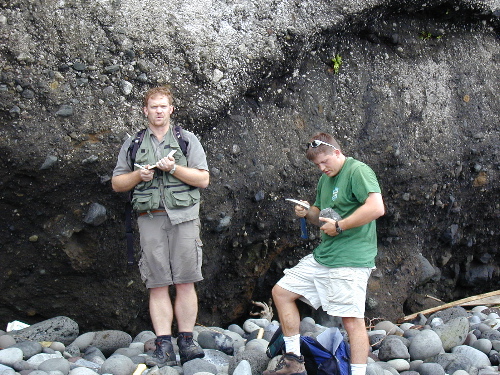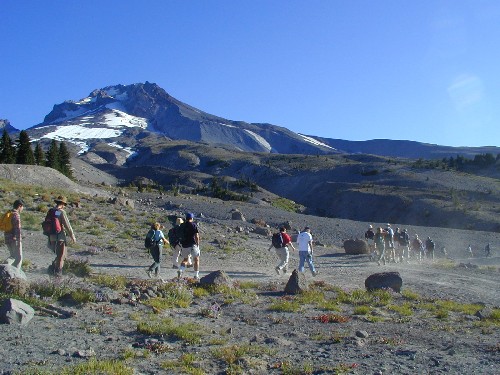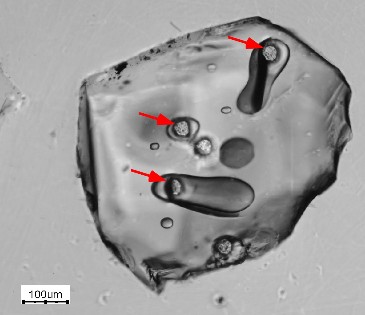Research Interests

My research interests largely centre around the study of igneous rocks, particularly those derived from the earth's mantle, and the development and application of laboratory techniques for making micro-scale chemical analyses of rocks and other solids materials. I am also interested in the role of volatile elements in the generation of magmas, and I retain an interest in the formation of ore deposits, which was the subject of my Ph.D. (all those years ago...).
Right: It all begins with rocks. Here Mike Rowe (on the right) and myself do our best not to look confused as we examine volcanic rocks from the Japanese island of Izu-Oshima. Photo by Jun-Ichi Kimura.
Origin and evolution of the earth’s mantle-derived magmas
The
earth has been around for some time now.
Continual extraction of the crust at Mid Ocean Ridges and re-injection of oceanic crust
into the mantle at
subduction zones, as well as the effects of mantle plumes and other straaaaaannngggeee
processes have left their indelible mark on both the crust and mantle. I am
interested in using the chemical and isotopic
compositions of mantle-derived magmas, as well as any other pertinent and/or
germane information, to understand how these magmas form and they can be used to
constrain the nature of the mantle and the long term evolution of the earth.
Left: Henriette Hansen using a solar cell to charge batteries for a satellite telephone in the remote Prince of Wales Mountains, East Greenland. These rocks represent part of the gigantic North Atlantic Magmatic province formed when a large mantle plume appeared under Greenland and Northern Europe (they were joined together at the time) about 60 million years ago.
Volcanism and geochemical processing at subduction zones
 Apart
from being intrinsically fascinating things, volcanoes and volcanic rocks
also tell us many things about the innards of the earth.
Frinstance, most of the earths crust has probably
come out of a volcano at one time or another. At subduction zones, such
as the famous circum-Pacific "Ring of Fire" (which includes our local
Cascade arc), volcanism is one expression of the intensive chemical processing that occurs as oceanic crust
is pulled back into the mantle.
Apart
from being intrinsically fascinating things, volcanoes and volcanic rocks
also tell us many things about the innards of the earth.
Frinstance, most of the earths crust has probably
come out of a volcano at one time or another. At subduction zones, such
as the famous circum-Pacific "Ring of Fire" (which includes our local
Cascade arc), volcanism is one expression of the intensive chemical processing that occurs as oceanic crust
is pulled back into the mantle.
Volatile elements, particularly hydrogen In the form of good old water), play an important role in this cycling and are one of my particular interests.
Above: A posse of geologists strides it out in front of Mount Hood at the 2003 State of the Arc conference. Mt Hood, the highest point in Oregon, is one of the Cascade volcanoes - manifestations of the subduction of the Pacific and associated plates beneath western North America.
Study of silicate melt inclusions in igneous rocks
Trapped within crystals in many igneous rocks are tiny bubbles of melt, left there as the crystal grew and isolated them from the
surrounding magma. They may be small
(typically << 100 microns, or 0.0001 m in diameter)
Right: A microscopic view of melt inclusions trapped in an olivine crystal from
Development of in-situ microanalysis techniques for geochemical and other applications
The world is a big place, but interesting things come in small packages too.
Micro-analysis techniques let us look at the chemical and isotopic compositions
of materials at ludicrously small spatial scales (sometimes 1 micron or less).  Techniques rely on small focused beams of electrons, x-rays, ions or laser
pulses to interact with materials on small length scales (generally between 1 -
100 microns). Laser and ion beams actually remove small amounts of materials
which can then be measured by mass spectrometers. Electrons and X-rays stimulate
emission of characteristic X-rays specific to different elements.
There are applications in many fields, including geology and geochemistry,
biology, material sciences, forensic science, archeology and many others.
Read
more about this in the microanalysis page.
Techniques rely on small focused beams of electrons, x-rays, ions or laser
pulses to interact with materials on small length scales (generally between 1 -
100 microns). Laser and ion beams actually remove small amounts of materials
which can then be measured by mass spectrometers. Electrons and X-rays stimulate
emission of characteristic X-rays specific to different elements.
There are applications in many fields, including geology and geochemistry,
biology, material sciences, forensic science, archeology and many others.
Read
more about this in the microanalysis page.
Left: Pits left after laser ablation analysis of melt inclusions in an olivine from the Lau Basin. Red arrows mark three pits - all are 40 micron in diameter (the scale bar shown is 100 microns).
[Microanalysis Page] [Do some laser ablation at OSU]